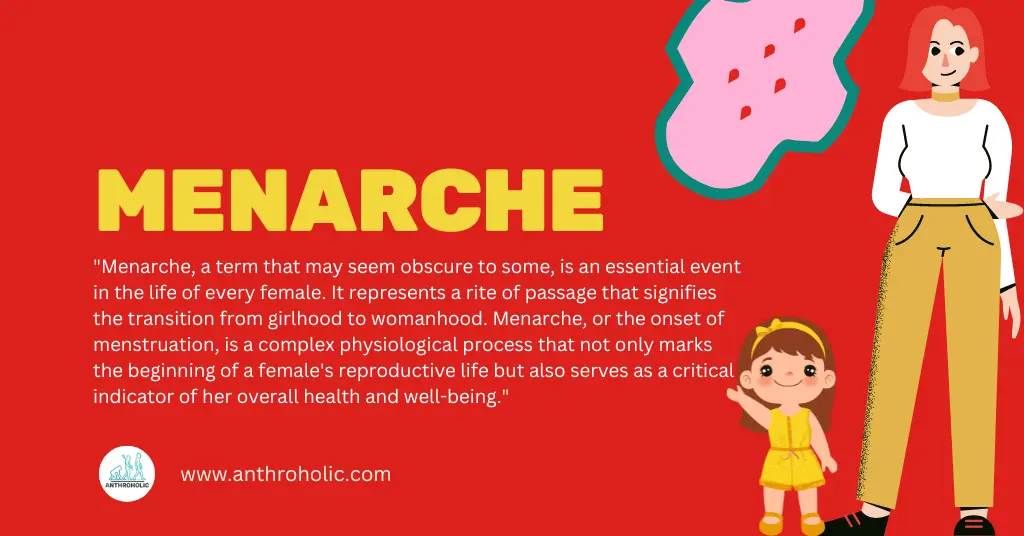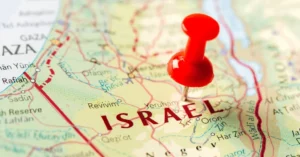AI Answer Evaluation Platform Live Now. Try Free Answer Evaluation Now
Menarche
Menarche, a term that may seem obscure to some, is an essential event in the life of every female. It represents a rite of passage that signifies the transition from girlhood to womanhood. Menarche, or the onset of menstruation, is a complex physiological process that not only marks the beginning of a female’s reproductive life but also serves as a critical indicator of her overall health and well-being.

Physiology of Menarche
A. Hormonal Changes
The onset of menarche is primarily governed by hormonal changes within the body (Table 1). During puberty, the hypothalamus, a part of the brain that regulates hormones, releases gonadotropin-releasing hormone (GnRH). This hormone triggers the release of two other hormones: luteinizing hormone (LH) and follicle-stimulating hormone (FSH). These hormones act on the ovaries, resulting in the production of estrogen and progesterone, which are responsible for the development of secondary sexual characteristics and the initiation of menstruation (Marshall & Tanner, 1969).
| Hormone | Role in Menarche |
|---|---|
| GnRH | Triggers the release of LH and FSH from the anterior pituitary gland |
| LH | Stimulates the production of estrogen and progesterone in the ovaries; plays a role in the maturation of ovarian follicles |
| FSH | Works with LH to stimulate the growth and maturation of ovarian follicles, which contain the eggs |
| Estrogen | Responsible for the development of secondary sexual characteristics, such as breast development and widening of the hips; regulates the growth of the uterine lining (endometrium) in preparation for possible implantation of an embryo |
| Progesterone | Works with estrogen to regulate the menstrual cycle; prepares the endometrium for possible implantation of an embryo |
B. Menstrual Cycle
The menstrual cycle, which typically lasts 28 days, can be divided into several phases (Table 2). The follicular phase begins on the first day of menstruation and continues until ovulation, around day 14. During this phase, FSH and LH stimulate the growth and maturation of ovarian follicles. At the end of the follicular phase, the mature follicle releases an egg, a process called ovulation. The luteal phase begins after ovulation and lasts until the start of the next menstrual period. During this phase, the ruptured follicle forms the corpus luteum, which secretes progesterone to maintain the endometrium in case of pregnancy. If the egg is not fertilized, the corpus luteum breaks down, and menstruation begins (Kipke, 1999).
| Phase | Days | Description |
|---|---|---|
| Follicular | 1-14 | FSH and LH stimulate the growth and maturation of ovarian follicles; estrogen levels rise, causing the endometrium to thicken in preparation for possible implantation |
| Ovulation | 14 | The mature follicle releases an egg, which travels down the fallopian tube towards the uterus |
| Luteal | 15-28 | The corpus luteum secretes progesterone to maintain the endometrium; if the egg is not fertilized, the corpus luteum breaks down, progesterone levels drop, and menstruation begins |
C. Age of Menarche
The age at which a girl experiences her first menstrual period can vary widely, with most girls starting between the ages of 9 and 16 (Anderson, Dallal, & Must, 2003). Several factors can influence the age of menarche, including genetics, nutritional status, and overall health. Recent trends suggest that the average age of menarche is decreasing, which has been attributed to improvements in nutrition, healthcare, and living conditions (Wyshak & Frisch, 1982).
Cultural Significance of Menarche
A. Rites of Passage
In many cultures, menarche is considered a significant event that marks a girl’s transition into womanhood. Rites of passage are often associated with this event, including ceremonies, rituals, and celebrations. These traditions vary widely between cultures and can serve to provide support, education, and guidance for the young woman as she navigates her newfound status (Apter, 1995).
B. Taboos and Misconceptions
Despite the natural occurrence of menstruation, it is often shrouded in secrecy and taboo. In some cultures, menstruating women are considered impure or unclean and may be subjected to restrictions, such as being prohibited from participating in certain activities or entering religious spaces (Buckley & Gottlieb, 1988). These taboos can perpetuate misconceptions and stigma surrounding menstruation and may contribute to the lack of comprehensive menstrual education for young girls.
Challenges and Opportunities
A. Menstrual Hygiene Management
Menstrual hygiene management (MHM) is crucial for the health and well-being of menstruating individuals. Access to clean and safe sanitary products, as well as proper disposal methods, is essential for maintaining hygiene during menstruation. However, in many parts of the world, access to these resources remains limited, and girls may face significant challenges in managing their periods (Sommer, Caruso, Sahin, Calderon, Cavill, & Mahon, 2016).
B. Menstrual Education
Comprehensive menstrual education is vital in ensuring that girls are well-equipped to navigate the changes they experience during puberty. This education should cover not only the biological aspects of menstruation but also its cultural and social implications. In addition, it should aim to debunk myths and misconceptions surrounding menstruation and promote a positive, open dialogue about this natural process (Chrisler, Marván, Gorman, & Rossini, 2018).
C. Menarche and Mental Health
The onset of menarche can be accompanied by various emotions, including excitement, anxiety, and confusion. It is essential to provide adequate support for girls as they navigate this transition, addressing any mental health concerns that may arise. Encouraging open communication and providing a safe space for girls to express their feelings and ask questions can be invaluable in promoting mental well-being during this time (Koff & Rierdan, 1995).
Future Directions in Menarche Research and Support
A. Technological Innovations
The advent of new technologies offers promising opportunities to improve menstrual hygiene management and education. Innovations such as biodegradable sanitary products, reusable menstrual cups, and period-tracking apps can make menstruation more sustainable, affordable, and user-friendly. Additionally, digital platforms can provide accessible and engaging menstrual education resources to a broader audience (Bobel, 2019).
B. Intersectional Approaches
An intersectional approach to menarche acknowledges that girls’ experiences are shaped not only by their biological sex but also by factors such as race, ethnicity, socio-economic status, and geographic location. By considering the diverse contexts in which girls experience menarche, researchers, policymakers, and educators can develop more inclusive and effective strategies for supporting girls during this critical period (Crenshaw, 1989).
C. Global Initiatives and Policy
National and international efforts are needed to address the various challenges associated with menarche, including menstrual hygiene management, education, and mental health support. Global initiatives, such as the United Nations’ Sustainable Development Goals, can help raise awareness of the importance of addressing menarche-related issues and encourage governments to implement policies that prioritize the well-being of girls during this transitional period (United Nations, 2015).
D. Promoting Gender Equality and De-stigmatizing Menstruation
Addressing the stigma surrounding menstruation is critical in creating a more equitable society where both males and females understand and respect the natural process of menstruation. By engaging men and boys in conversations about menstruation and promoting gender equality, we can create a culture of understanding and support that benefits everyone (Mahon, Fernandes, & Boydell, 2019).
E. Fostering Community Involvement
Community-based interventions can play a significant role in supporting girls during menarche. Local organizations, schools, and religious institutions can create spaces for girls to access menstrual hygiene resources, participate in educational programs, and engage in open conversations about menstruation. These community-driven initiatives can help normalize menstruation and provide essential support for girls as they navigate this transitional period (Mason, Nyothach, Alexander, Odhiambo, Eleveld, Vulule, … & Phillips-Howard, 2013).
F. Comprehensive Sexual Education
Incorporating menarche education within a broader framework of comprehensive sexual education can help equip young people with the knowledge and skills they need to make informed decisions about their reproductive health. By addressing menstruation in the context of overall sexual health, educators can provide a more holistic understanding of the biological, social, and emotional aspects of puberty and human sexuality (Haberland & Rogow, 2015).
Conclusion
Menarche is a complex and multifaceted event that signifies a significant milestone in a female’s life. By understanding the physiological changes that occur during this time, appreciating the cultural significance of menarche, and addressing the challenges and opportunities it presents, we can better support girls as they navigate this critical transition. Comprehensive menstrual education, access to menstrual hygiene resources, and mental health support are key components in fostering a positive and empowering experience for young women during menarche and beyond.
References
- Anderson, S. E., Dallal, G. E., & Must, A. (2003). Relative weight and race influence average age at menarche: results from two nationally representative surveys of US girls studied 25 years apart. Pediatrics, 111(4 Pt 1), 844-850. https://pubmed.ncbi.nlm.nih.gov/12671122/
- Apter, D. (1995). Hormonal events during female puberty in relation to breast development and age at menarche. Acta Obstetricia et Gynecologica Scandinavica, 74(S159), 7-11.
- Buckley, T., & Gottlieb, A. (1988). Blood Magic: The Anthropology of Menstruation. University of California Press.
- Chrisler, J. C., Marván, M. L., Gorman, J. A., & Rossini, M. (2018). The perimenstrual phase and women’s psychological and physical health. In Women’s reproductive health across the lifespan (pp. 133-158). Routledge.
- Kipke, M. D. (1999). Adolescent development and the biology of puberty: Summary of a workshop on new research. National Academies Press.
- Koff, E., & Rierdan, J. (1995). Preparing girls for menstruation: recommendations from adolescent girls. Adolescence, 30(120), 795-811.
- Marshall, W. A., & Tanner, J. M. (1969). Variations in pattern of pubertal changes in girls. Archives of Disease in Childhood, 44(235), 291-303.
- Sommer, M., Caruso, B. A., Sahin, M., Calderon, T., Cavill, S., & Mahon, T. (2016). A time for global action: addressing girls’ menstrual hygiene management needs in schools. PLoS Medicine, 13(2), e1001962.
- Wyshak, G., & Frisch, R. E. (1982). Evidence for a secular trend in age of menarche. New England Journal of Medicine, 306(17), 1033-1035.
- Bobel, C. (2019). The managed body: Developing girls and menstrual health in the global south. Palgrave Macmillan.
- Crenshaw, K. (1989). Demarginalizing the intersection of race and sex: A black feminist critique of antidiscrimination doctrine, feminist theory and antiracist politics. University of Chicago Legal Forum, 1989(1), 139-167.
- Haberland, N., & Rogow, D. (2015). Sexuality education: Emerging trends in evidence and practice. Journal of Adolescent Health, 56(1), S15-S21.
- Mahon, T., Fernandes, M., & Boydell, V. (2019). Menstrual hygiene management and human rights: The case for an evidence-based approach. Women’s Studies International Forum, 76, 100694.
- Mason, L., Nyothach, E., Alexander, K., Odhiambo, F. O., Eleveld, A., Vulule, J., … & Phillips-Howard, P. A. (2013). ‘We keep it secret so no one should know’–a qualitative study to explore young schoolgirls attitudes and experiences with menstruation in rural western Kenya. PLoS One, 8(11), e79132.
- United Nations. (2015). Transforming our world: The 2030 agenda for sustainable development. New York, NY: United Nations.



